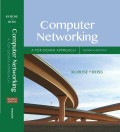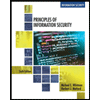
EBK COMPUTER NETWORKING
7th Edition
ISBN: 8220102955479
Author: Ross
Publisher: PEARSON
expand_more
expand_more
format_list_bulleted
Question
Chapter 4, Problem R24RQ
Program Plan Intro
Host:
- A host is a computer system or any device connected to other system or device in a network to exchange the data.
- A network host provides required information or data resources, services, applications and many others to other users present in the network.
- It can be a network node related to the network address.
Internet Protocol (IP):
Internet protocol is a process or protocol in which data is transferred between the computer systems through internet. Each computer system has its own IP address to send or receive the required data. It consists of five different layers namely, application layer, transport layer, network layer, link layer and physical layer.
Datagram:
- In networking, a datagram is a transferring unit which is used to transfer the data from a source to the destination and it doesn’t provide guaranteed service.
- It includes fragmentation process which is defined as the division of the data packet into small one when the data packets are larger than the maximum length of a particular system.
Expert Solution & Answer
Trending nowThis is a popular solution!

Students have asked these similar questions
Consider the figure below with hosts A to F, and interfaces assigned IP and MAC addresses. Suppose all of the ARP
tables are up to date and Host A sends a datagram to Host F. Give the source and destination MAC and IP addresses
in the frame encapsulating this IP datagram as the frame is transmitted (i) from A to the left router, (ii) from the left
router to the right router, and (iii) from the right router to F.
E
192.168.1.001
00-00-00-00-00-00
192.168.2.001
44-44-44-44-44-44
192.168.3.001
77-77-77-77-77-77
Router 1
192.168.1.002
192.168.2.002
192.168.2.003
22-22-22-22-22-22 33-33-33-33-33-33
55-55-55-55-55
192.168.2.004
192.168.1.003
D
66-66-66-66-66
11-11-11-11-11-11
from A to Router 1
Router 1 to Router 2
LAN
B
Source MAC
address
Destination
MAC address
Source IP
Destination
IP
LAN
Router 2
LAN
192.168.3.002
88-88-88-88-88-88
F
from Router 2 to F
192.168.3.003
99-99-99-99-99-99
1. What is the difference between packet fragmentation (i.e., at network layer) and frame frag-
mentation (i.e., at link layer) in terms of purpose?
2. Suppose that host A is connected to a router R1, R1 is connected to another router, R2, and
R2 is connected to host B. Suppose that a TCP message that contains 800 bytes of data and
20 bytes of TCP header is passed to the IP function at host A for delivery to B. Show the
Total length, DF, MF, and Fragment offset fields of the IP header in each packet transmitted
over the three links. (Assume that link A-R1 can support a maximum frame size of 1024
bytes including a 14-byte frame header, link R1-R2 can support a maximum frame size of 512
bytes, including an 8-byte frame header, and link R2-B can support a maximum frame size
of 432 bytes including a 12-byte frame header.)
(*hint: the Fragment offset field is denominated by 8-bytes, not bytes)
3. What is the purpose of the path MTU discovery process (see textbook Figure 5-42) and why
does…
Data collision is caused when many senders access the same medium at the same time; which protocol(s) and at what layer(s) are available to handle this problem? Is a transfer without collisions guaranteed by using these protocols? In the event that this is not the case, what other possibilities exist for finding a solution to the issue?
Chapter 4 Solutions
EBK COMPUTER NETWORKING
Ch. 4 - Lets review some of the terminology used in this...Ch. 4 - Prob. R2RQCh. 4 - Prob. R3RQCh. 4 - Prob. R4RQCh. 4 - Prob. R5RQCh. 4 - Prob. R6RQCh. 4 - Prob. R7RQCh. 4 - Prob. R8RQCh. 4 - Prob. R9RQCh. 4 - Prob. R10RQ
Ch. 4 - Prob. R11RQCh. 4 - Prob. R12RQCh. 4 - Prob. R13RQCh. 4 - Prob. R14RQCh. 4 - Prob. R15RQCh. 4 - Prob. R16RQCh. 4 - Prob. R17RQCh. 4 - Prob. R18RQCh. 4 - Prob. R19RQCh. 4 - Prob. R20RQCh. 4 - Prob. R21RQCh. 4 - Prob. R22RQCh. 4 - Prob. R23RQCh. 4 - Prob. R24RQCh. 4 - Prob. R25RQCh. 4 - Prob. R26RQCh. 4 - Prob. R27RQCh. 4 - Prob. R28RQCh. 4 - Prob. R29RQCh. 4 - Prob. R30RQCh. 4 - Prob. R31RQCh. 4 - Prob. R32RQCh. 4 - Prob. R33RQCh. 4 - Prob. R34RQCh. 4 - Prob. R35RQCh. 4 - Prob. P1PCh. 4 - Prob. P2PCh. 4 - Prob. P3PCh. 4 - Consider a datagram network using 32-bit host...Ch. 4 - Consider a datagram network using 8-bit host...Ch. 4 - Consider a datagram network using 8-bit host...Ch. 4 - Prob. P8PCh. 4 - Prob. P9PCh. 4 - Prob. P10PCh. 4 - Prob. P11PCh. 4 - Prob. P12PCh. 4 - Consider sending a 2400-byte datagram into a link...Ch. 4 - Prob. P15PCh. 4 - Prob. P16PCh. 4 - Prob. P17PCh. 4 - Prob. P18PCh. 4 - Prob. P19PCh. 4 - Prob. P20PCh. 4 - Prob. P21PCh. 4 - Prob. P22P
Knowledge Booster
Similar questions
- Consider sending a 2400-byte datagram into a link that has an MTU of 700 bytes. Suppose the original datagram is stamped with the identification number 422. How many fragments are generated? What are the values in the various fields in the IP datagram(s) generated related to fragmentation?arrow_forwardThe maximum transmission unit on an Ethernet link is 4500 bytes. This means that the IP packets sent over Ethernet cannot be larger than 4500 bytes including the IP header. Suppose the application layer sends a 6500-byte message. The transport layer uses TCP with no options. The network layer is using IP version 4. Obviously, the IP layer will have to fragment the data. Provide the length of new datagrams (after fragmentation). Provide the Flag and offset of each of the new datagrams.arrow_forwardConsider sending a 2,300-byte datagram into a link that has an maximum transmiting unit (MTU) of 650 bytes. Suppose the original datagram is stamped with the identification number 291. How many fragments are generated? What are the values in the various fields in the IP datagram(s) generated related to fragmentation.arrow_forward
- R6Fragmentation of an IP datagram takes place if its size is larger than the MTU of the subnet over which the datagram will be routed. Most IP datagram reassembly algorithms have a timer to avoid having a lost fragment tie up reassembly buffers forever. Suppose a datagram is fragmented into four fragments. The first three fragments arrive, but the last one is delayed. Eventually the timer goes off and the three fragments in the receiver's memory are discarded. A little later, the last fragment stumbles in. What should be done with it?arrow_forward4. Consider a datagram network using 8-bit host addresses. Suppose a router uses longest prefix matching and has the following forwarding table: Prefix Match Interface 10 010 1 0110 2 0111 3 11 4 00 For each of the six interfaces, give the associated range of destination host addresses and the number of addresses in the range.arrow_forwardConsider the network setup in the following figure where the router is NAT-enabled. Suppose each host has two ongoing TCP connections, all to port 80 at host 128.119.40.86. Provide the six corresponding entries in the NAT translation table. Assume that the router assigns port number starting from 3000 and each host assigns port number starting in 5000arrow_forward
- Host A and B are communicating over a TCP connection, and Host B has already received from A all bytes up through byte 126. Suppose Host A then sends two segments to Host B backto-back. The first and second segments contain 80 and 40 bytes of data, respectively. In the first segment, the sequence number is 127, the source port number is 302, and the destination port number is 80. Host B sends an acknowledgment whenever it receives a segment from Host A. d. Suppose the two segments sent by A arrive in order at B. The first acknowledgment is lost and the second acknowledgment arrives after the first timeout interval. Draw a timing diagram, showing these segments and all other segments and acknowledgments sent. (Assume there is no additional packet loss.) For each segment in your figure, provide the sequence number and the number of bytes of data; for each acknowledgment that you add, provide the acknowledgment number.arrow_forwardConsider sending a 3500-byte datagram that has arrived at a router R₁ that needs to be sent over a link that has an MTU size of 1000 bytes to R2. Then it has to traverse a link with an MTU of 600 bytes. Let the identification number of the original datagram be 465. How many fragments are delivered at the destination? Show the parameters associated with each of these fragments.arrow_forwardHost A and B are communicating over a TCP connection, and Host B has already received from A all bytes up through byte 126. Suppose Host A then sends two segments to Host B backto-back. The first and second segments contain 80 and 40 bytes of data, respectively. In the first segment, the sequence number is 127, the source port number is 302, and the destination port number is 80. Host B sends an acknowledgment whenever it receives a segment from Host A.a. In the second segment sent from Host A to B, what are the sequence number, source port number, and destination port number?b. If the first segment arrives before the second segment, in the acknowledgment of the first arriving segment, what is the acknowledgment number, the source port number, and the destination port number?c. If the second segment arrives before the first segment, in the acknowledgment of the first arriving segment, what is the acknowledgment number?d. Suppose the two segments sent by A arrive in order at B. The…arrow_forward
- Host A and B are communicating over a TCP connection. Host B has already received from Host A all bytes up through byte 23. Suppose Host A then sends two segments to Host B back-to-back. The first and the second segments contain 30 and 50 bytes of data, respectively. In the first segment, the sequence number is 24, the source port number is 3000, and the destination port number is 80. Host B sends an acknowledgment whenever it receives a segment from Host A. A. In the second segment sent from Host A to B, what arethe sequence number_________,source port number __________,and destination port number__________?B. If the second segment arrives after the first segment, in the acknowledgment of the second segment, what arethe acknowledgment number___________,the source port number__________,and the destination port number __________?C. If the second segment arrives before the first segment, in the acknowledgment of the first arriving segment,what is the acknowledgment number ___________?D.…arrow_forwardHost A and B are communicating over a TCP connection, and Host B has already received from A all bytes up through byte 126. Suppose Host A then sends two segments to Host B back-to-back. The first and second segments contain 80 and 40 bytes of data, respectively. In the first segment, the sequence number is 127, the source port number is 302, and the destination port number is 80. Host B sends an acknowledgment whenever it receives a segment from Host A. a. In the second segment sent from Host A to B, what are the sequence number, source port number, and destination port number? b. If the first segment arrives before the second segment, in the acknowledgment of the first arriving segment, what is the acknowledgment number, the source port number, and the destination port number? c. If the second segment arrives before the first segment, in the acknowledgment of the first arriving segment, what is the acknowledgment number? d. Suppose the two segments sent by A arrive in order at B. The…arrow_forwardConsider an IP packet with a length of 4,500bytes that includes a 20-byteIPv4 header ans 40-byte TCP header. The packet is forwarded to an IPv4 router that supports a Maximum Transmission Unit (MTU) of 600bytes. Assume that the length of the IP header in all the outgoing fragments of this packet is 20bytes. Assume that the fragmentation offset value stored in the first fragment is 0. The fragmentation offset value stored in the third fragment isarrow_forward
arrow_back_ios
SEE MORE QUESTIONS
arrow_forward_ios
Recommended textbooks for you
 A+ Guide To It Technical SupportComputer ScienceISBN:9780357108291Author:ANDREWS, Jean.Publisher:Cengage,
A+ Guide To It Technical SupportComputer ScienceISBN:9780357108291Author:ANDREWS, Jean.Publisher:Cengage, Principles of Information Security (MindTap Cours...Computer ScienceISBN:9781337102063Author:Michael E. Whitman, Herbert J. MattordPublisher:Cengage Learning
Principles of Information Security (MindTap Cours...Computer ScienceISBN:9781337102063Author:Michael E. Whitman, Herbert J. MattordPublisher:Cengage Learning Systems ArchitectureComputer ScienceISBN:9781305080195Author:Stephen D. BurdPublisher:Cengage Learning
Systems ArchitectureComputer ScienceISBN:9781305080195Author:Stephen D. BurdPublisher:Cengage Learning

A+ Guide To It Technical Support
Computer Science
ISBN:9780357108291
Author:ANDREWS, Jean.
Publisher:Cengage,

Principles of Information Security (MindTap Cours...
Computer Science
ISBN:9781337102063
Author:Michael E. Whitman, Herbert J. Mattord
Publisher:Cengage Learning

Systems Architecture
Computer Science
ISBN:9781305080195
Author:Stephen D. Burd
Publisher:Cengage Learning